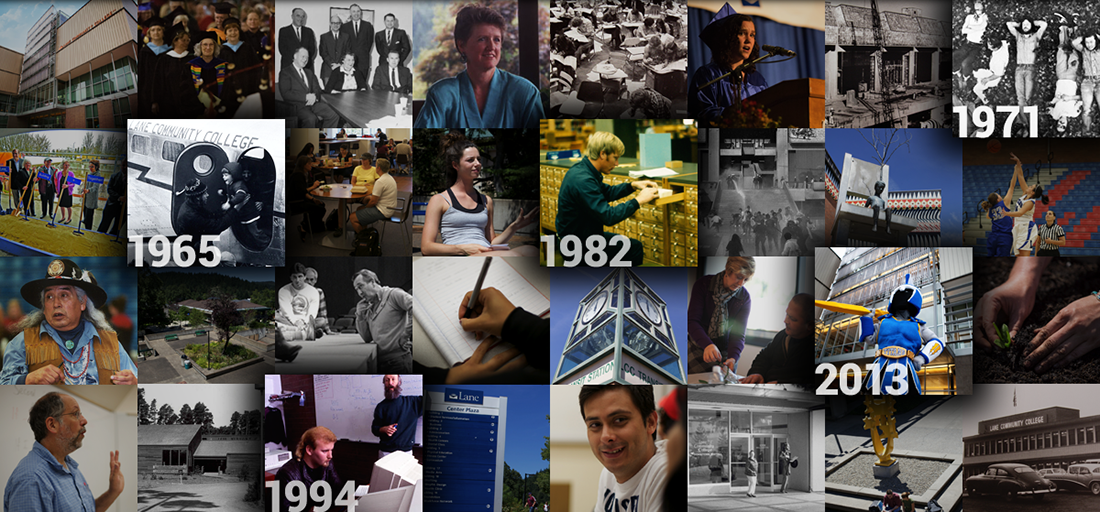
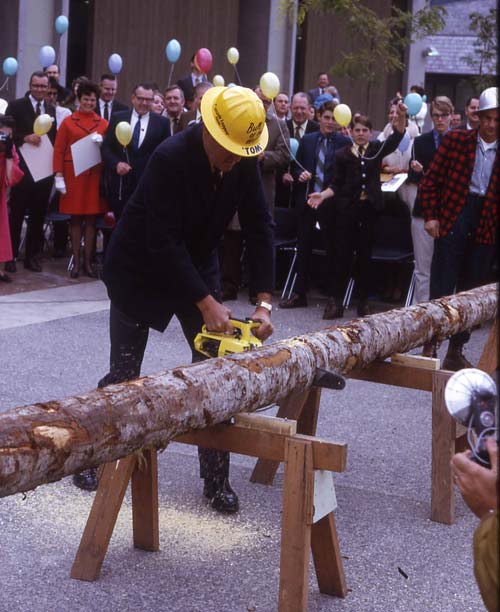
- 1964: Lane Community College is founded following voter approval and election of the Board of Education.
- 1965: Dr. Dale Parnell, county Education District superintendent and former Springfield High principal, is appointed Lane’s first president.
- 1965: Lane officially opens temporary facilities and begins the first regular year of instruction with 138 staff members and enrollment of 1,435 full-time students.
- 1965: The community’s new college is named after Lane County.
- 1965: The first student body is elected; the student constitution is approved; Titan is selected as the school mascot; the student newspaper is named The Torch (first issue is published this year).
- 1966: Lane’s first class of 163 students graduates.
- 1966: Voters approve a $9.9 million construction bond for a new 30th Avenue campus.
- 1967: KLCC-FM begins broadcasting.
- 1968: Classes begin at the new 30th Avenue campus in southeast Eugene.
- 1968: The Florence outreach program in local schools is established.
- 1968: The Northwest Association of Schools and Colleges awards Lane its first full accreditation.
- 1969: Lane dedicates the new $18 million campus with Oregon Governor Tom McCall cutting a log with a chainsaw for the event (instead of a traditional ribbon cutting).
Oregon Governor Tom McCall at the new campus dedication ceremony (1969)
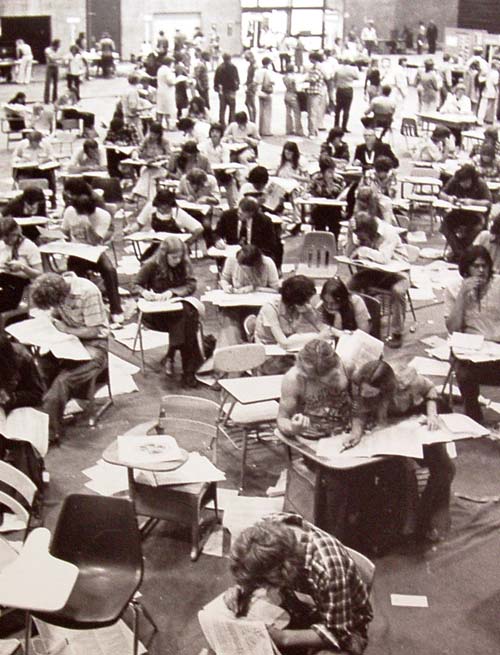
- 1971: Lane hosts the Grateful Dead benefit concert for Financial Aid and the White Bird Clinic. More than 7,000 people attend.
- 1971: The student literary magazine, "Concrete Statement" (later "Denali"), publishes its first issue.
- 1972: Lane is recognized by the U.S. Office of Education as one of six best examples of a comprehensive technical-vocational community college.
- 1972: The men’s cross-country team wins the national competition.
- 1976: After providing classes in the community for eight years, the Florence Center opens to serve as a hub for education in west Lane County
- 1977: Downtown Center opens on Willamette Avenue in Eugene, and the Central Area Education Center opens in Cottage Grove.
- 1977: The American Association of Community and Junior Colleges cites Lane as one of the nation’s best six colleges for exemplary outreach, counseling, and vocational testing programs for women.
- 1977: Mobile Classroom begins visiting outlying communities.
- 1979: Lane receives the Health, Education and Welfare Award for significant contributions to the education of students with disabilities.
- 1979: Lane begins offering telecourses.
Student registration (1976)

- 1980: Lane cuts Kilowatt-hours consumption by 50 percent.
- 1981: Business Assistance Center opens.
- 1984: National Commission for Cooperative Education ranks Lane's Cooperative Work Experience program the largest of its kind in the U.S. and Canada.
- 1984: Lane initiates an exchange program with Nagasaki Wesleyan Junior College in Kyushu, Japan.
- 1984: Lane helps form and houses the Oregon Small Business Development Network.
- 1985: Lane is selected as one of the top five community colleges in the country by a panel of national educators convened by the Community College Leadership Program.
- 1987: Lane’s Transitions to Success program for single parents/displaced homemakers is started with a federal grant.
- 1988: Lane receives an award from the Annenberg Corporation for Public Broadcasting project for extensive use of television courses to expand educational opportunities.
- 1988: Career Information Center receives Les Adkins Award for career guidance excellence from the Career Information System Board.
- 1988: KLCC-FM is ranked first in the country among public radio stations for reaching the highest percentage of audience.
- 1988: Lane's on-campus infant/toddler childcare center opens.
Beth Naylor, registered dietician and Lane instructor for more than 30 years (1987)
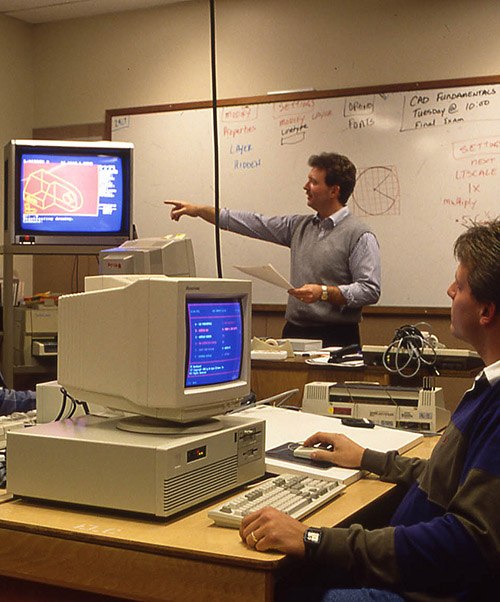
- 1990: Lane's 600,000th student is enrolled.
- 1993: Lane helps recruit Symantec, a software company, to Eugene and trains 90 new employees for the company.
- 1994: Community leaders break ground for Lane's new aviation maintenance facility at the Eugene Airport.
- 1994: The Lane Foundation brings in more than $1.4 million in 1993-94, making it one of 30 community college foundations in the nation to raise more than $1 million in annual contributions.
- 1995: Voters approve a $42.8 million construction bond, the first bond request since the Main Campus was built.
- 1995: Lane's home page debuts on the Internet: lanecc.edu.
- 1996: Lane's first online course is offered.
- 1996: Lane breaks ground on its new Cottage Grove Center.
- 1996: Lane and the African American Community Coalition establish the African American Rites of Passage Summer Academy.
- 1997: Lane's Learning Center at Thurston High School holds a grand opening. It is the first of eight neighborhood facilities funded by the construction bond.
- 1998: The Community Learning Center project receives the Exemplary Program Award in Distance Learning from the National Council for Continuing Education and Training.
- 1999: LCC Foundation receives a $2 million gift from the estate of Ralph and Gilma Greenhoot, the largest single gift to Lane's Foundation since its inception in 1971.
CAD software class (circa 1990)
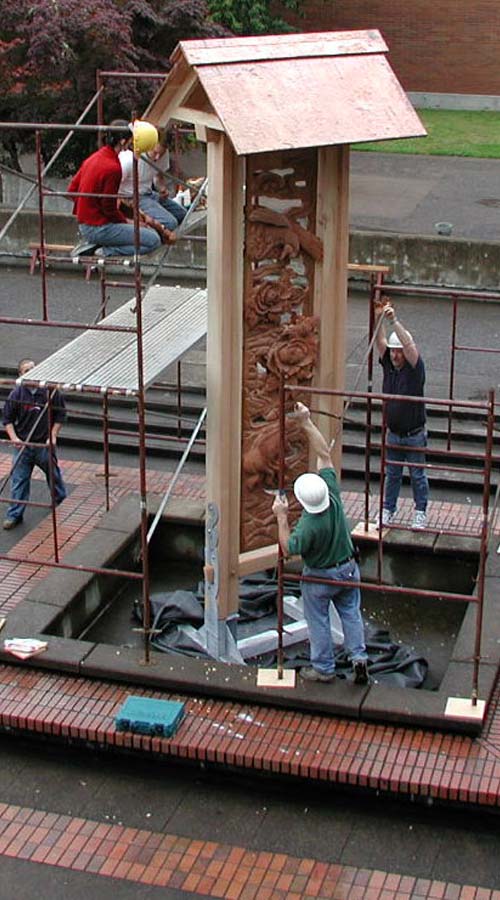
- 2000: Lane is selected as one of only 12 Vanguard Learning Colleges in the U.S. and Canada for its outstanding record of achievement in improving learning.
- 2000: A greatly expanded evening program is launched, offering night and weekend classes in 17 credit degree programs.
- 2001: Dr. Mary Spilde is chosen as Lane's sixth president by unanimous resolution of the Board of Education.
- 2001: Lane and the University of Oregon announce a dual admission and enrollment program.
- 2003: The Center for Meeting and Learning opens. The facility is a learning lab offering conference and catering services provided by culinary and hospitality instructors, students, and professional staff.
- 2003: ExpressLane, a self-service web tool, replaces telephone registration with online registration.
- 2004: Lane partners with high schools to form the Regional Technical Education Consortium (RTEC) offering vocational and technical training on campus for high school and college credit.
- 2005: The Association of Oregon Recyclers names Lane “Recycler of the Year.” At the time, 52 percent of all Lane’s waste is recycled or reused, accounting for more than 343 tons of batteries, food waste, sawdust, paper, metal, glass, motor oil, and other materials.
- 2006: Lane teams up with Oregon State University to offer a co-enrollment program.
- 2006: The Geographic Information Science (GIS) curriculum is established thanks to a $782,144, three-year grant from the National Science Foundation.
- 2006: Lane breaks ground for a Native American Longhouse, the nation’s first at a non-tribal community college.
- 2007: The Lane Peace Center debuts.
- 2008: Voters renew bond funding. The $83 million, 15-year measure helps update instructional facilities, equipment, and technology.
- 2009: Opening Doors, Lane's first capital construction campaign, kicks off with six gifts, totaling $6.4 million, to help establish a new Health and Wellness building, a faculty endowment, a scholarship endowment, and an innovation fund.
Installation of the Long Life statue on Lane’s main campus. Students in Lane’s sculpture class created the mahogany relief panel with two master woodcarvers from Japan. (2004)
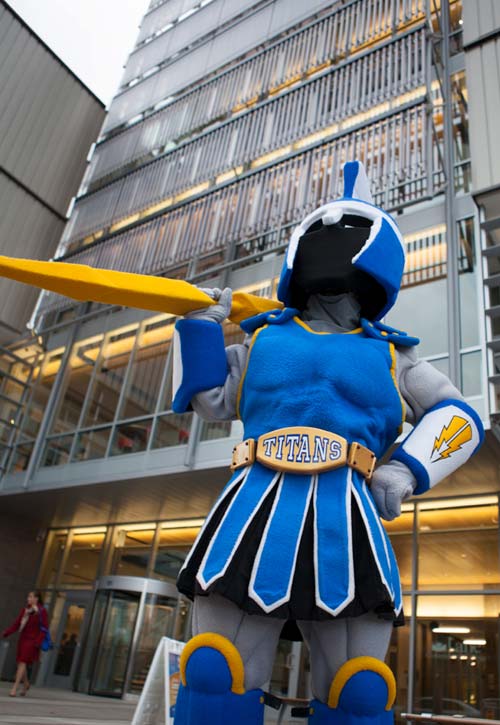
- 2010: The Health and Wellness Center holds its grand opening.
- 2010: Lane purchases 10th and Charnelton site for $1 from the City of Eugene to build a new Downtown Center.
- 2011: Lane Titans Women's Basketball team celebrates the nation's longest home-court winning streak of 83 consecutive home game wins over the last eight years.
- 2011: The American Association of Community Colleges names Lane alumnus Rosaria Haugland an Outstanding Alumni. She co-founded Molecular Probes, which became a multimillion-dollar business.
- 2012: AARP Foundation awards $200,000 for the Plus Project, a two-year initiative to put people age 50 and older back to work by providing reservation sales training to 100 low income and long-term unemployed senior workers.
- 2012: BikeLane is piloted to promote health and sustainable practices. The pilot program provides commuter-style bikes and gear for students who can’t otherwise afford them.
- 2012: U.S. Olympic Track and Field Trials names Lane as its official training site.
- 2012: Small Business Development Center receives 2012 State and Regional Excellence and Innovation Awards from the U.S. Small Business Administration.
- 2012: Lane’s Employee Gala honors approximately 1,000 years of collective service and celebrates its first 40-year employee, Sue Thompson.
- 2012: Lane's first student housing project, Titan Court, opens to students.
- 2012: A children's dental clinic opens at the Cottage Grove Center.
- 2012: The first Hybrid Electric Vehicle auto technology class is offered.
- 2012: The Maxwell Student Veteran Center is dedicated.
- 2012: Staff begins moving into the new Downtown Center.
- 2013: Lane begins renovating the Center Building on Main Campus.
Ty Titan greets visitors to Lane’s first student housing complex, Titan Court. The apartment complex opened to students in 2012.
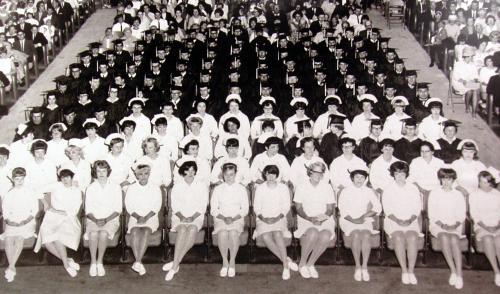
Visit the Archives for a more in-depth exploration of Lane's history and important milestones.
Lane’s first graduating class (1966)


